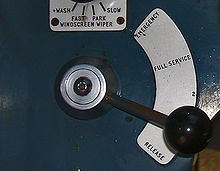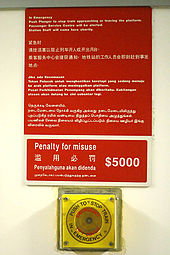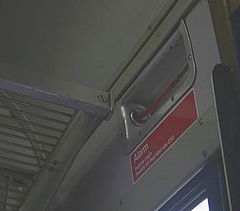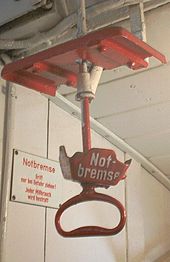- Emergency brake (train)
-
This article is about emergency brakes on trains. For emergency brakes in cars, see hand brake.
On trains, the expression emergency brake has several meanings:
- The maximum brake force available to the driver/engineer from his conventional braking system, usually operated by taking the brake handle to its furthest postion, through a gate mechanism, or by pushing a separate plunger in the cab
- a completely separate mechanism from the conventional braking system, designed to stop the train as quickly as possible
- a handle or plunger which may be applied by a passenger in an emergency situation, either operating the brakes directly or sending an alarm to the driver so that he can stop the train
The emergency brake applies considerably more braking force than the standard full-service brake. The engineer, motorman or driver will only use the emergency brake as a last resort, since it may cause damage; even with modern wheel slide protection, a train may develop wheel-flats, and the rails themselves can suffer profile damage.
Contents
Possible consequences of operating the Emergency brake
Putting the engineer's brake handle into the emergency position may also:
- Shut off traction power
- On an electric train, drop the pantograph if the power supply is overhead-wire traction current, or raise the pickup shoes where the supply is third-rail traction current
- Disable Dynamic braking
- Prevent the brakes from being released until the train has stopped
- Connect the brake wires to ground, to prevent a "false-feed" voltage from releasing the brakes
- Send an emergency radio signal, if the brake handle has been in the emergency position for over 30 seconds
Passenger-applied brakes
Trains often have a facility in each car to enable passengers to apply the brakes in case of emergency. In many modern trains, the driver is able to prevent brake activation when a passenger operates the emergency alarm [1] - an audible warning is sounded, and the driver is then able to talk to the person who activated the alarm on the intercom and see them on an internal CCTV. The driver can press an override button and hold the brakes off whilst he chooses a safe place to stop the train. Severe fines are in place to dissuade people from activating the brake without good reason.
Mechanism on locomotive-hauled stock with brake pipe
The alarm chain in a passenger coach is designed to create a break in the continuity of the brake pipes (whether vacuum or air brakes), immediately resulting in a loss of brake pressure (or vacuum) and thereby causing the train brakes to be applied. With vacuum brakes, a clappet valve is provided, which is released by the pulling of the alarm chain; with air brakes, there is a similar passenger emergency valve which can vent the brake pipe to the air.
In most locomotives (in addition to a warning lamp or buzzer being sounded) the master controller undergoes auto-regression, with the notches falling to zero rapidly as the locomotive's motive power is switched off. The guard may also notice the loss of brake pressure (although he may not know it is due to the pulling of the alarm chain) and is expected to apply his brakes immediately also. It is possible for a driver to override the alarm-chain pull; this is done where it is known that miscreants resort to pulling the emergency chain solely to get the train to stop at a point convenient for themselves. However, such an act by the driver (or guard) of deliberately ignoring an indication of alarm-chain pulling is a serious matter.
In recent years locomotives have been fitted with emergency flashers on the roof of the cab, and these flashers are also activated when the brake pipe pressure is lost for any reason other than the driver's application of the brake valve. This alerts drivers of oncoming trains of the possibility of a derailed or parted rake which may foul other tracks (since brake pressure may have been lost for those reasons as well); at the locomotive, it is not possible to tell whether the loss of brake pressure is due to the pulling of the alarm chain.
ACP (alarm chain pulling) also causes a small lever to be released near the emergency brake valve (usually mounted near one end of the coach), which does not retract to its normal position even when the chain is released. This allows the driver (or guard) to find out in which coach the ACP actually occurred. When the coach is isolated, the lever needs to be manually reset. Until this is done, the lamp and buzzer in the locomotive cab are continuously activated. A circuit breaker controls the lamp and alarm bell in the locomotive cab; in cases where defective equipment causes the lamp and bell to go off, the driver can disable them by placing the MCB (master circuit breaker) in the "off" position. Despite the obvious safety hazards, sometimes this is resorted to by drivers when driving trains through sections where spurious ACP incidents are very common.[2]
Emergency brakes worldwide
India
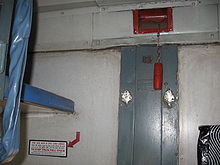 Emergency brake on a train in India
Emergency brake on a train in India
Chain-pulling is the act of pulling a cord that activates the train's emergency brakes to stop a train, whether for a genuine emergency or (often) illegally for someone to get on or off the train on the Indian Railway network.[3] Chain-pulling is rampant on Indian railways, where miscreants use it to make unscheduled stops near their destination. Penalties for misuse of this facility include a fine of Rs. 1,000 and/or a prison sentence of up to one year. Because of the rampant misuse of this facility, former President of India APJ Abdul Kalam proposed an alternate method wherein a passenger in an emergency communicates with the guard and driver of the train.[4]
USA
In some passenger train cars, the emergency brake is a cord that passengers may pull to activate. In the cabs of light-rail cars the emergency brake is often a large red button, which the train crew refers to as the "mushroom"; this also activates the magnetic track brakes. The mechanism of an emergency brake may differ, depending on railcar design. Emergency-braking a train (without track brakes) will give about 1.5 m/s2 (0.15 g) deceleration. The braking distance will be approximately 250 m (820 ft) at 100 km/h (62 mph) and 600 m (2,000 ft) at 160 km/h (99 mph). High-speed trains are usually equipped with a magnetic track brake, which can give about 0.3 m/s2 extra, and give braking distances like 850 m (2,790 ft) at 200 km/h (120 mph) and 1,900 m (6,200 ft) at 300 km/h (190 mph).
United Kingdom
Emergency brakes were introduced in the United Kingdom by the Regulation of Railways Act 1868. Section 22 stated, "All trains traveling a distance of more than 20 miles without stopping are to be provided with a means of communication between the passengers and the servants of the company in charge of the train". At first, this means of communication was a cord running down the length of the train at roof level outside the carriages, connected to a bell on the locomotive. When the use of automatic brakes was made compulsory in the Regulation of Railways Act 1889, the equipment was modified so that it operated the brakes; however, the term "communication cord" has survived. Until the 1970s a "cord" (by that time a chain) was still used, which ran the length of the carriage and connected to a valve at one end which opened the brake pipe. A butterfly valve on the side of the carriage was used to reset the brake, and also made it easy for the train crew to see in which coach the cord had been pulled. Later designs used handles which were activated by pulling down; more recent types use buttons connected to a PassComm system. On modern trains with sliding doors the body-indicator light (BIL), usually used to show that doors on a carriage are open, will flash when the brake has been used.
Pulling the alarm chain on a British train will pull a lever connected to the brake pipe flaps. Pulling the alarm activates a piston, causing the flaps to be opened and all the air pushed out the air tube, forcing the brakes on. In the driver's cab, a buzzer and a light will tell that the alarm has been activated. In the guard's, van this is seen from a valve which shows loss of pressure in the brake pipe. In the UK, there is a fine of £25 for pulling the alarm chain without good reason.
Override
In most rolling stock built since the 1980s passenger communication handles (or PassComms) have been installed, which activate an alarm in the driver's cab when used. If the train is not in a safe place (in a tunnel or on a bridge, for example) the driver has approximately three seconds to override the alarm by pressing a button before the brakes automatically apply. The driver may also speak to the person who pulled the handle via an intercom mounted alongside the handle. On modern trains this is particularly useful, since the PassComm must be much easier to use and more accessible due to accessibility regulations; this makes accidental activation easier. On some modern trains, the PassComm in the accessible toilet is mounted such that it is often confused with the door or flush control; this sometimes leads to accidental activation.
London Underground
When London Underground began converting trains for one-person-operation during the 1970s and 1980s, the original emergency brake systems were replaced by an alarm and a passenger-communication system. On earlier systems the brakes were not applied automatically (being under the control of the driver), whereas later systems have an override as above. On older systems, marker boards showing an exclamation mark were provided on departure from each station at the point where the rear of the train would no longer be at the platform. Normally, if the alarm was activated before the board the driver would stop the train, and otherwise continue to the next station. These boards were replaced by a number of boards counting up the number of cars that are beyond the end of the platform; for example, on a line with six-car trains the boards show 1, 2, 3, 4, 5, 6. When a train has stopped, they help the driver to see how much of the train is at the platform. With the help of passenger communication and available station staff, the driver can then decide whether to deal with the situation as it is, continue to the next station or possibly reverse back into the station (after consulting with line controllers and proper safety measures). During hot summer weather passengers are warned against using the emergency alarms if feeling unwell, since it can delay trains and increase the problem; they are instead instructed to leave the train at the next station and get some fresh air or a cold drink.
Russia
In Russian trains there is usually an emergency brake known as a "stop valve" (Russian: стоп-кран). In elektrichkas and other trains it is usually located near the doors, and sometimes in the middle of the car as well. A stop valve usually has a distinctive red handle. Turning the handle down (counter-clockwise) by about 90 degrees causes pneumatic brakes to engage, due to pressure loss in the standard air-braking system. While primitive and not allowing any override such a system is effective, resembling usual train brake activation; it does not fail in emergency conditions. More complicated systems may not provide quick braking when needed, or during a communications failure. Emergency braking is somewhat risky; it is hard on passengers, and there is a risk of passenger injury if braking occurs at high speed. As a result, use of a stop valve without good reason is prohibited and may lead to fines. Depending on circumstances and consequences, authorities may even arrest a person for the incorrect use of a stop valve.
Subways
In subways, derailment is usually less dangerous (speeds are lower, trains cannot jackknife in tunnels and so on). It is dangerous to stop in a tunnel if a fire develops; an emergency exit could lead to electrocution by the third rail (energized with 825 volts DC). Instead drivers try to reach the next station, even in an emergency. As a result, there are no emergency brakes directly visible to passengers. However, there are hidden stop valves and simplified train controls, allowing each car to act on its own in need. In an emergency, there are door-control handles (visible to passengers) which are intended to make the pneumatic train doors able to be opened by removing air pressure. Subway trains have mechanisms and alarms which prevent trains from moving if the doors are open, and alert the driver or engage the brakes if doors open while a train is moving. Penalties for misuse of emergency door-opening handles are similar to those for stop-valve misuse.
External signaling
The common signal to apply the emergency brake is to shake a highly-visible object vigorously near the track.[5] This can prevent a collision if the signaling person has had time to run some distance from the obstacle, giving more room for the train to stop. Penalties for misuse are the same as those for applying the brakes from inside the train.
Images
Further reading
- Hall, Stanley (1989). Danger on the Line. Ian Allan.
References
- ^ Southeastern Traction Manual - Class 465/6: Passenger Communication Equipment
- ^ "Railway Operation". Indian Railway Fan Club. http://www.irfca.org/faq/faq-ops2.html. Retrieved 2007-01-14.
- ^ "Jargon and Technical Terms, etc.". Indian Railway Fan Club. http://www.irfca.org/faq/faq-jargon.html. Retrieved 2007-01-14.
- ^ "Kalam has a solution for chain-pulling in trains". One India. 2006-05-22. http://news.oneindia.in/2006/05/22/kalam-has-a-solution-for-chain-pulling-in-trains-1148301456.html. Retrieved 2007-01-14.
- ^ How to signal a train to stop using only your arms and/or hands? Retrieved 2011-07-09.
See also
- Air brake (rail)
- Air brake (road vehicle)
- Dead-man's brake
- Hydraulic brake
- Hand brake
- Pulled tail
Railway brakes Railway brake types Railway brake manufacturers Faiveley Transport · Knorr-Bremse (New York Air Brake) · Westinghouse Air Brake Company · Westinghouse Brake and Signal Company LtdOther aspects of railway braking Brake van · Diesel brake tender · Diesel electric locomotive dynamic braking · Electronically controlled pneumatic brakes · Electro-pneumatic brake system on British railway trains · Emergency brake (train) · RetarderRelated brake articles Categories:- Vehicle braking technologies
- Train protection systems
Wikimedia Foundation. 2010.

